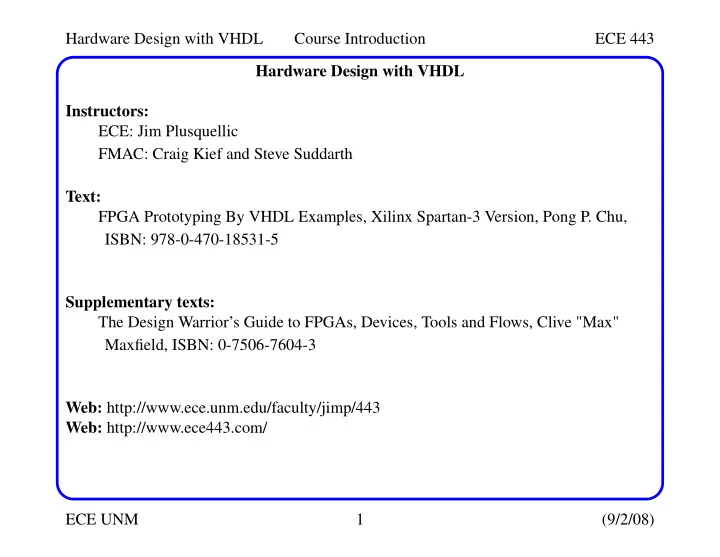

Hardware Design with VHDL Course Introduction ECE 443 Hardware Design with VHDL Instructors: ECE: Jim Plusquellic FMAC: Craig Kief and Steve Suddarth Text: FPGA Prototyping By VHDL Examples, Xilinx Spartan-3 Version, Pong P. Chu, ISBN: 978-0-470-18531-5 Supplementary texts: The Design Warrior’s Guide to FPGAs, Devices, Tools and Flows, Clive "Max" Maxfield, ISBN: 0-7506-7604-3 Web: http://www.ece.unm.edu/faculty/jimp/443 Web: http://www.ece443.com/ ECE UNM 1 (9/2/08)
Hardware Design with VHDL Course Introduction ECE 443 Course Description This course covers: • Programmable device technologies and architectures • Hardware description languages: VHDL • Design flows • Finite state machines (FSM) • System design considerations • FPGA hardware Prerequisites: ECE 338: Intermediate Logic Design (C or better) Familiarity with Test & Measurement equipment Familiarity with FSM design ECE UNM 2 (9/2/08)
Hardware Design with VHDL Course Introduction ECE 443 EDA Electronic design automation (EDA) is the practice of using computer-based software systems to design VLSI circuits. Many tools exist within EDA -- we focus here on the hardware description lan- guages (HDL), in particular VHDL . HDLs enable designers to write computer-based descriptions of the proper- ties, signals and functionality of a circuit. Traditional approach for the designer is to work at the gate or transistor level. Today, designers capture their designs in software, at higher levels of abstrac- tion. This methodology is coupled with synthesis tools to translate and opti- mize the description of the design. Synthesis engines map the design to physical parts such as an ASIC or FPGA. ECE UNM 3 (9/2/08)
Hardware Design with VHDL Course Introduction ECE 443 EDA Despite the powerful features available in such an approach, HDLs have not been widely accepted because: • Many designs are of a size and complexity that allow schematic entry to be used successfully. • Many engineers lack a working familiarity with HDLs. Design flow Design specifications summarize the functional behavior , timing require- ments , and other relevant attributes including speed , power and area . Design entry is the process of encapsulating a representation of the design, i.e., schematic, state transition diagrams, HDL, etc. Each step in the design flow either: • Creates a database supporting the design flow • Verifies that the design meets specific criteria ECE UNM 4 (9/2/08)
Hardware Design with VHDL Course Introduction ECE 443 Design Flow A design flow starts with design entry and ends with photomasks or a pro- gramming file (for FPGAs). A successful design might require multiple, iterative passes through all or part of this flow. First design flow Second design flow Create gate-level desc. Write VHDL (consider testability) (consider testability) Verify/Simulate Verify/Simulate (generate test patterns) Verify timing Synthesize/optimize gate-level netlist Create masks DRC/extract parasitics ECE UNM 5 (9/2/08)
Hardware Design with VHDL Course Introduction ECE 443 Design Flow There are several physical realizations of the design in hardware. Each offers trade-offs with respect to time-to-market, cost, and performance. full-custom to amortize, time to Market volume std. cells prototype FPGAs, gate arrays VLSI course PLDs This course NRE cost, process complexity, density, speed, complexity ECE UNM 6 (9/2/08)
Hardware Design with VHDL Course Introduction ECE 443 Design Entry As indicated, design entry encapsulates a description of the design in a data- base that serves subsequent steps in the design flow. Schematics and HDLs are the two commonly used modes of entry. Schematic entry focuses on the structural detail of the design. Advantages: Familiarity of the designer with this visual format Disadv: Supports only a low to moderate level of circuit complexity. Almost all CAD tools support this mode of design entry, many with fancy graphical interfaces and verification tools. Divide and conquer through hierarchical decomposition is extensively used. a sum b sum a c_out b c_out Symbol Schematic ECE UNM 7 (9/2/08)
Hardware Design with VHDL Course Introduction ECE 443 Design Entry A HDL is a programming language with special constructs and semantics to model , represent , and simulate the function and timing of the hardware. Variables are used to represent electrical signals. Their semantics include both a value and time . This allows the temporal relationship of the signals to be described, generated and manipulated. Tools exist that convert the HDL text to schematic automatically. HDLs allow the designer to describe the design as a structural entity (such as that required by schematic). HDLs also allow the designer to describe the design as a behavioral entity , using procedural code. This decouples the description of the design from actual physical hard- ware. ECE UNM 8 (9/2/08)
Recommend
More recommend